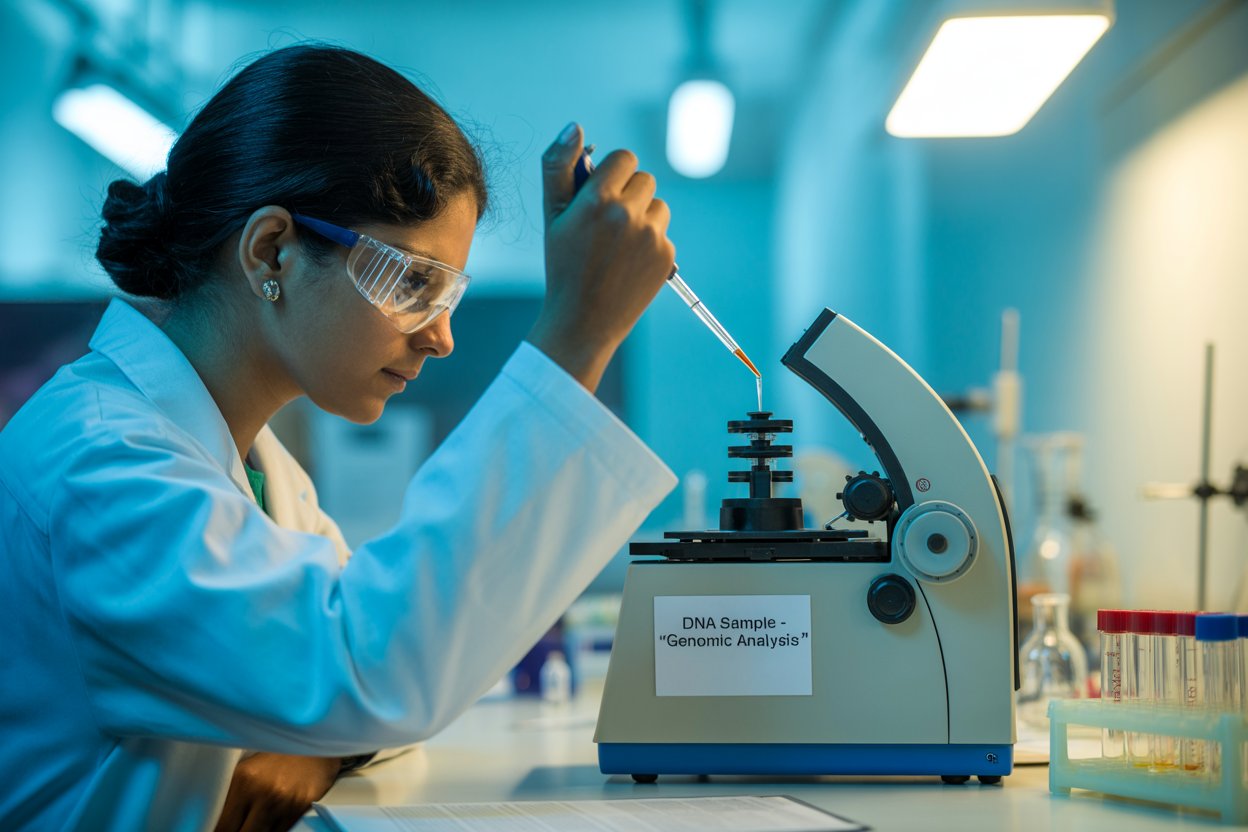Introduction
Spectrophotometry is a widely used technique in molecular biology for measuring the concentration and purity of nucleic acids and proteins. The NanoDrop 2000, a compact microvolume spectrophotometer, allows these measurements using just 0.5–2 µL of sample — ideal for when sample availability is limited.
With the ability to scan from 190–840 nm, NanoDrop provides quick, accurate, and reliable absorbance data for DNA, RNA, proteins, dyes, and more, making it an indispensable tool in labs around the world.
What Is Spectrophotometry and How Is It Used in This Setting?
Spectrophotometry is the measurement of how much light a substance absorbs at specific wavelengths. In biological labs, it’s used to:
- Quantify nucleic acids (DNA, RNA)
- Check sample purity
- Detect contaminants
- Assess labeling efficiency (for fluorescent probes)
The NanoDrop 2000 works by passing UV light through a tiny droplet of sample held between two optical fibers using surface tension. It detects the intensity of transmitted light and calculates absorbance, which is then translated into concentration using built-in formulas.
What All Parameters Can Be Measured Using NanoDrop?
| Parameter | Wavelength | What It Indicates |
|---|---|---|
| A260 (OD260) | 260 nm | DNA/RNA concentration |
| A280 (OD280) | 280 nm | Protein contamination |
| A230 (OD230) | 230 nm | Salt/organic contaminant contamination |
| A340 (OD340) | 340 nm | Background/baseline correction |
| 260/280 Ratio | — | DNA vs. protein purity (normal range is between 1.8-2.0) |
| 260/230 Ratio | — | DNA vs. chemical purity (ideal range is above 2.0) |
| Concentration | — | ng/µL, calculated from A260 |
| Full spectrum | 220–340 nm | Visual quality check |
Principles of Absorbance Photometry
The NanoDrop applies Beer–Lambert Law, which relates absorbance to concentration:
A = ε⋅c⋅l
Where:
- A = Absorbance (Optical Density)
- ε = Extinction coefficient (specific to each molecule)
- c = Concentration (mol/L or ng/µL)
- l = Pathlength (in cm; automatically adjusted in NanoDrop from 1.0 mm to 0.05 mm)
What is Optical Density (OD)?
OD (Optical Density) or Absorbance is a logarithmic measurement of how much light is absorbed by a sample:
OD = log10(I0/I)
Where:
- I0 = Incident light intensity
- I = Transmitted light intensity
OD values are used to quantify DNA and RNA by measuring absorbance at 260 nm.
What Are the 260/280 and 260/230 Ratios?
| Ratio | Ideal Range | Interpretation |
|---|---|---|
| 260/280 | ~1.8 (DNA), ~2.0 (RNA) | Lower values suggest protein contamination |
| 260/230 | ~2.0–2.2 | Lower values indicate chemical contaminants (e.g., salts, phenol, guanidine) |
| 260/280 > 2.0 | May occur with RNA contamination or very pure ssDNA; also if A280 is very low due to baseline fluctuation |
Why Are 260, 280, 230, and 340 nm Used?
| Wavelength | What It Detects | Why Chosen? |
|---|---|---|
| 260 nm | DNA & RNA | Nucleic acid bases (adenine, guanine, etc.) absorb maximally here |
| 280 nm | Proteins | Aromatic amino acids like tryptophan/tyrosine absorb UV here |
| 230 nm | Contaminants | Salts, phenol, EDTA, guanidine absorb strongly here |
| 340 nm | Background | Used for baseline correction and scattering due to bubbles or dirty pedestal |
What is “Baseline Correction at 340 nm”?
In NanoDrop measurements, baseline correction is a method used to subtract background noise or absorbance that is not due to nucleic acids or proteins. The value at 340 nm is often used for this purpose because:
340 nm is a wavelength where nucleic acids and proteins do not absorb significantly.
Purpose of Baseline Correction at 340 nm:
- Corrects for background absorbance due to:
- Dirty pedestal or cuvette
- Bubbles
- Residual solvents or buffer absorbance
- Instrumental drift
- Improves the accuracy of the absorbance readings at 260 nm and 280 nm by subtracting any absorbance at 340 nm from the whole spectrum.

How Is DNA Concentration Calculated Using OD?
NanoDrop uses a simplified Beer–Lambert equation with default extinction coefficients for nucleic acids:
Concentration (ng/µL)= A260 × ε
| Molecule | Extinction Coefficient (ε) |
|---|---|
| dsDNA | 50 ng·cm/µL |
| ssDNA | 33 ng·cm/µL |
| RNA | 40 ng·cm/µL |
The NanoDrop auto-adjusts for path length and reports normalized results to a 10 mm path (1 cm).
1 absorbance unit at 260 nm (A260 = 1.0) corresponds to 50 ng/µL of dsDNA.
Step-by-Step Guide: How to Use NanoDrop 2000
1. Setup
- Turn on the NanoDrop
- Open the software → Select “Nucleic Acid” → Choose sample type (DNA-50 for dsDNA)
2. Clean Pedestals
- Use a lint-free wipe and ethanol to clean both upper and lower pedestals
3. Blanking
- Load 1–2 µL of buffer (same buffer as used for the sample)
- Click Blank
4. Load Sample and Measure
- Pipette 1–2 µL of DNA onto the pedestal
- Lower the arm → Click Measure
- The software will show:
- DNA concentration (ng/µL)
- 260/280 and 260/230 ratios
- Full spectrum from 220–340 nm

5. Clean After Use
- Wipe both pedestals thoroughly
- Repeat for the next sample
Interpretation Table: What to Check After a Measurement
| Parameter | Ideal Value | Indicates | Abnormality Suggests |
|---|---|---|---|
| A260 | — | DNA present | Should be >0.1 for reliability |
| 260/280 | ~1.8 | Pure DNA | decreases in protein contamination; increases because of RNA or low A280 |
| 260/230 | ~2.0–2.2 | No chemical contamination | ↓ phenol/salt contamination |
| A340 | ~0 | Background baseline | ↑ suggests bubbles, smudges, or baseline drift |
| Full Spectrum | Peak at 260 nm | Expected for DNA | Shoulder or dip at 230/280 implies contamination |
Pro Tips
- If 260/280 > 2.0, suspect RNA carryover or extremely clean sample with low protein.
- If 260/230 < 1.5, check for leftover guanidine, phenol, or salts.
- Always use new aliquots for each measurement.
- Re-blank every 30 minutes for batch runs.
Disclaimer:
Genecommons uses AI tools to assist content preparation. Genecommons does not own the copyright for any images used on this website unless explicitly stated. All images are used for educational and informational purposes under fair use. If you are a copyright holder and want material removed, contact doctorsarath@outlook.com.



No responses yet